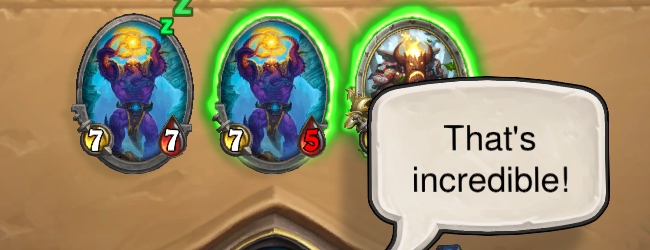
Before we get into the topic, let me tell you something about myself and how I finally made my way to Legend in season thirteen. I started playing Hearthstone in early beta and after reaching 3-star master (the highest rank at the time) before the official release, I was only one star away from rank 1 (and thus 6 stars away from Legend) in Hearthstone’s inaugural season. With almost a week to go until the reset, and at a time where the general player base hadn’t yet figured out the intricacies of our favorite card game, reaching Legend should have been a cinch, right? But I stopped, just because I had a bad streak which knocked me back down to rank 3 and destroyed my motivation for the rest of the month. Despite playing well enough to make it to rank 3-5 month after month, it would take me another year to finally push into Legend, simply because I would usually throw in the towel for the season once I hit a "wall" and lost a few too many games in a row.
So what happened here? What made me question my skill to an extent which knocked me out of the competition entirely time after time? For me, at least, the answer is simple: it was tilt. Tilt, which lead to bad decision-making, which lead to losses, which lead to tilting even harder. Eventually, with the expectation that I was going to lose the next game anyways, I withdrew from the ladder and broke the vicious cycle of losing and feeling worse and worse by removing myself from it. It wasn’t until a year later that I sat down, thought long and hard about my gameplay and made the (surprisingly easy) push into Legend for the first time.
Tilt, then, is both the cause and the result of bad gameplay; it’s the cause and result of bad decision-making and, perhaps most importantly, it’s both cause and effect of not enjoying the game. At the end of this article, you will have learned a) how to identify tilt, b) how it affects your results and c) how to minimize it or perhaps even eliminate it from your play outright. And while I will talk about the ladder first and foremost, be aware that tilt can (and will!) alter your play in tournaments as well, with the only difference being that it’s not you who is removing yourself from the competition, but your opponent who is going to capitalize on the mistakes you’re making while you’re on tilt.
Tilt, then, is both the cause and the result of bad gameplay; it’s the cause and result of bad decision-making and, perhaps most importantly, it’s both cause and effect of not enjoying the game.
Identifying tilt seems like it should be easy enough; just stop playing once you realize you’re not on your A-game anymore, right? However, tilt doesn’t announce itself or enter with a bang (well, sometimes it does; think about your opponent pulling a miracle [card]Reno Jackson[/card] from any random card effect and you’ll see what I mean); more often than not, tilt enters your game quietly and you begin to accept it as part of your regular gameplay. Thoughts such as “I knew he would have that card,” “of course I have to face the class which counters my deck again” and the like are good indicators of emotions starting to cloud your rationality. The game starts to feel unfair, predetermined ("perfect" [card]Knife Juggler[/card] hits, anyone?) or outright rigged in favor of your opponent. The fact that Hearthstone sometimes simply does come down to sheer luck helps foster tilt, as humans are (unfortunately) extremely good at seeing patterns where there are none. If you lose three coin flips in a row, you’re going to assume you’ll lose the next one, too, and that assumption, despite your better knowledge, is tilt in its purest form. Once you learn to identify these moments, you’re on your way to identifying what exactly puts you on tilt.

I promised you ways to reduce tilt, so there’s our first lesson: Identify true randomness and accept it. That means knowing when the result of an action is not influenced by your (or your opponent’s) actions and actively reminding yourself of that fact. "True" randomness, for example, could be [card]Arcane Missile[/card]s; outside of reducing potential targets before casting it, your opponent has no way of controlling the distribution of damage. If it happens to "perfectly" (notice the inverted commas!) kill your 2/3 minion, that’s luck. Not predetermination, not skill, just luck. If your Warrior opponent, however, kept his entire starting hand and happens to have a [card]Fiery War Axe[/card] in hand (as they do), that is not true randomness and you could potentially have used the information the game provided you with to play around it. "Of course he has an FWA" does not help you, nor is it fair toward your opponent; he included two in his deck, which means he has a rather good chance to start with one and he didn’t even mulligan! And you might have seen that and played around it (as much as you can play around an FWA, but bear with me here), had you not been on tilt. So try to think actively about randomness and categorize it into true and faux random effects (that is, random effects which you can alter or could try to play around) to stay calm and play your A-game.
"Of course he has a Fiery War Axe" does not help you, nor is it fair toward your opponent
But back to identifying tilt. One of the ways I identify tilt is thinking about whether I would mind getting spectated or even streaming right now. You probably realize you play differently when someone’s watching and you play even more differently when people see or hear your every reaction. Whenever I realize that I wouldn’t want anyone to tune into my game right now, either because I’m playing badly or because I’m being negative and react badly toward the game, I know I’m on tilt and finish my session. When I said earlier that tilt is hard to identify, I meant that it’s only hard to identify for yourself; an outsider will typically realize very quickly that you’re playing sub-optimally and might even question you about it! So the thought of "if someone saw me play like this, would they think I’m doing badly?", as simple as it is, might help you figure out when you’re tilted. Consequently, playing as if you’re being watched is a way of dealing with tilt. As most streamers will attest, your gameplay improves massively if you explain what you’re doing because it forces you to think twice about your actions instead of playing on autopilot. I’m not saying you should talk to your wall (maybe you have a cat?), but reflecting upon your own plays both improves your game and might help keeping you balanced.
I’ve gone into huge detail on the effects of negative tilt, but it should be noted that you can also go on positive tilt. Things just work out, you win every coin flip, you play against decks you counter perfectly for your entire session, your opponent disconnects and you gain a free star. Life is good, Hearthstone is fun, you’re a big winner. Much like the feeling of losing games undeservedly, winning too much can put you on tilt, too! You’re going to think less about your game, you might overextend on the board (because hell, you’re on a winning streak and the last five opponents keeled over by turn six!) or stop playing around counters you know could be there, like the aforementioned Fiery War Axe. Positive tilt is much harder to identify than negative tilt because it just Feels. So. Damn. Good! You are, however, playing just as badly as if you were tilted negatively and might need to calm down in order to play ideally again. I’m not telling you not to have fun with Hearthstone but if you want to be successful, knowing when you’ve gotten too lucky is a skill you have to sharpen along with everything else.
Positive tilt is much harder to identify than negative tilt because it just Feels. So. Damn. Good!
Now we’ve learned why tilt is bad for your game and we’ve learned how to identify it. The next logical step, then, is to try and reduce it. I’m not going to say eliminate it, because that might well be impossible! Unfortunately, I have to preface this section with a disclaimer: no single tip will remove your potential for tilt altogether and nothing works for everyone! These tips are merely things which worked for me (as well as a handful of people I recommended them to and who inspired me to write this piece) and even if not one of them changes anything about your potential for tilt, the way of thinking about your game I tried to outline in the paragraphs above combined with these practical hints might help you find your own solutions. I invite you to share them with us in the comment section below!

First and foremost: Set aside time to play.
That means starting your sessions with purpose and knowing just about how much time you have to play. (We’re going to talk about when to abort a session below.) Try to minimize distractions and focus on both your own gameplay as well as your opponent’s: how long are they taking to play their cards, what could they have in hand, what might the rest of their deck look like, etc. Keep your head in the game for as long as you can and try to absorb as much information as the game and your opponent offer you. Now I know some of you will argue that watching a TV show or browsing as a distraction might be helpful to them (especially if your opponent is roping you), but the less time you have to think, the more you will rely on your instincts and the "autopilot", and the more you will play intuitively. While that might be nice, it also opens you up to making gut decisions, which, as we have learned, might not be in your best interest. Most importantly, I found that focusing solely on Hearthstone helps me find out when I’m not having fun anymore, a warning you should not ignore (see above!)
Count in losses, not wins.
Many people try to climb the ladder thinking "if I gain five stars per day, I’ll reach legend in three weeks' time,” or aim to win a certain number of games per day on their way up. While that’s mathematically correct, it opens you up to frustration if you fail to reach those wins or keep bouncing up and down for longer periods of time. Instead of doing that, I have looked at my stats and estimated how many losses I would need in order to reach legend. I found that five losses per day (so 150 in a month) would put me at 250-150 at a 62.5% win rate, which should be enough to make legend every month. I went ahead and promised myself to lose five games per day until I reached legend, which had two effects: it minimized my fear of losses (because I accepted them as part of my climb) and it gave me something to strive for whenever I had a bad day. If I lost three out of my first five games, I knew that I would “only” have to lose two more and my workload for the day would be finished, which calmed me down because I put a limit on the game’s potential to frustrate me. Thinking in losses instead of wins lead to a more positive outlook on the rest of my session and kept me from tilting.
Keep track of great matches and mismatches you’ve beat
It sounds simple but when asked about our most memorable matches, most of us will remember crushing losses and games which seemed unfair and predetermined (see above) from the get-go. Whenever I sit down to climb the ladder or play in a tournament, I make an effort to remember the games where I handed out a "bad beat"; those times when my deck just clicks and the game is over within four minutes, or games where my opponent gets dealt a bad hand and loses even though he was a 65% favorite to win. While I normally use my deck tracker to keep track of this, I take notes and screenshots of extreme outliers just to remind myself that it’s not just my opponents who get lucky sometimes. Keeping track of beating the decks which counters yours also helps reduce frustration when you queue into them several times in a row: you know you’ve beat them before, you know you can do it again! Just like counting in losses, putting more emphasis on the times when you got lucky is a simple trick you can play on yourself in order to put your other results into perspective.
Make an effort to remember the games where you handed out a "bad beat."
In conclusion, tilt typically cannot be eliminated entirely, but it can be dealt with and managed. If you keep a close eye on your games and find out what triggers you specifically, your risk of tilting, and with that your results, should improve noticeably. At the very least, it should help you keep your spirits high during those times when the game just doesn’t seem like a fair contest. And who knows, maybe that tiny bit of improvement is enough to push you into Legend or make you win the next tournament!

